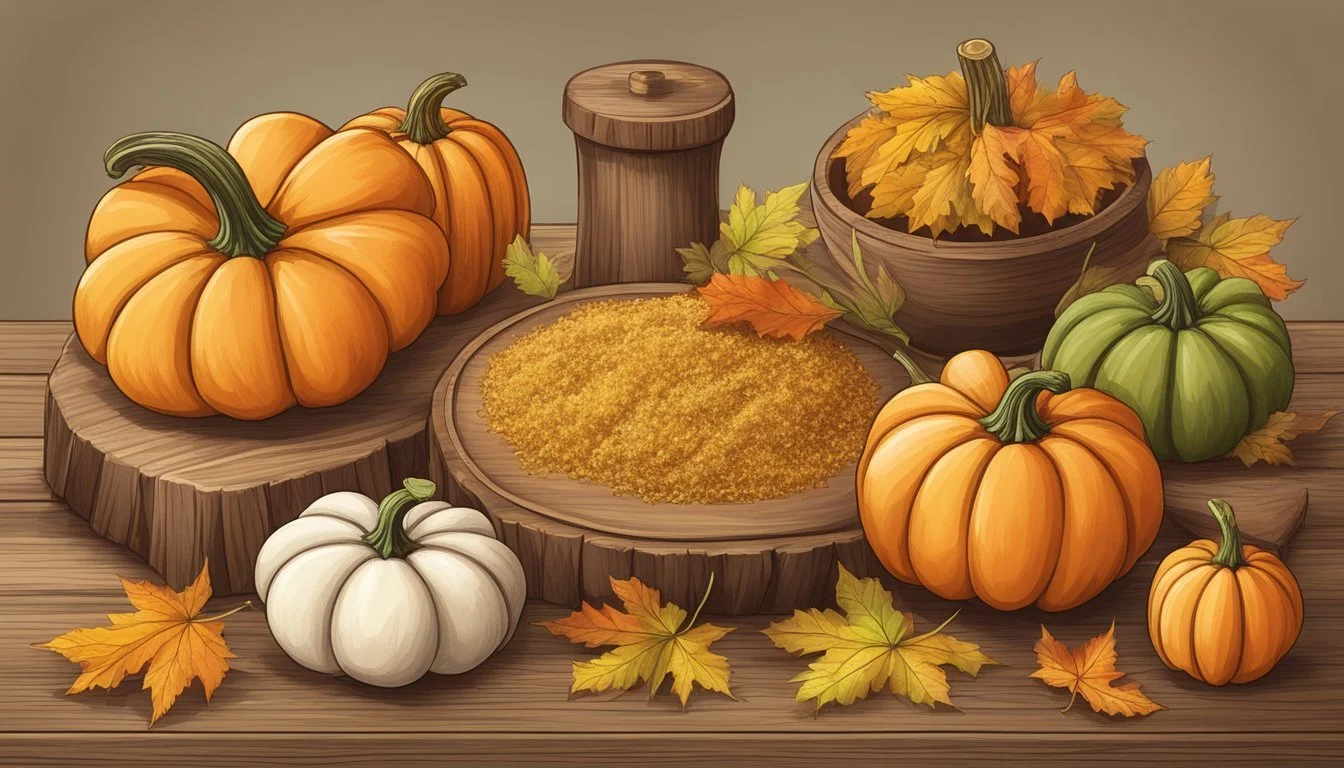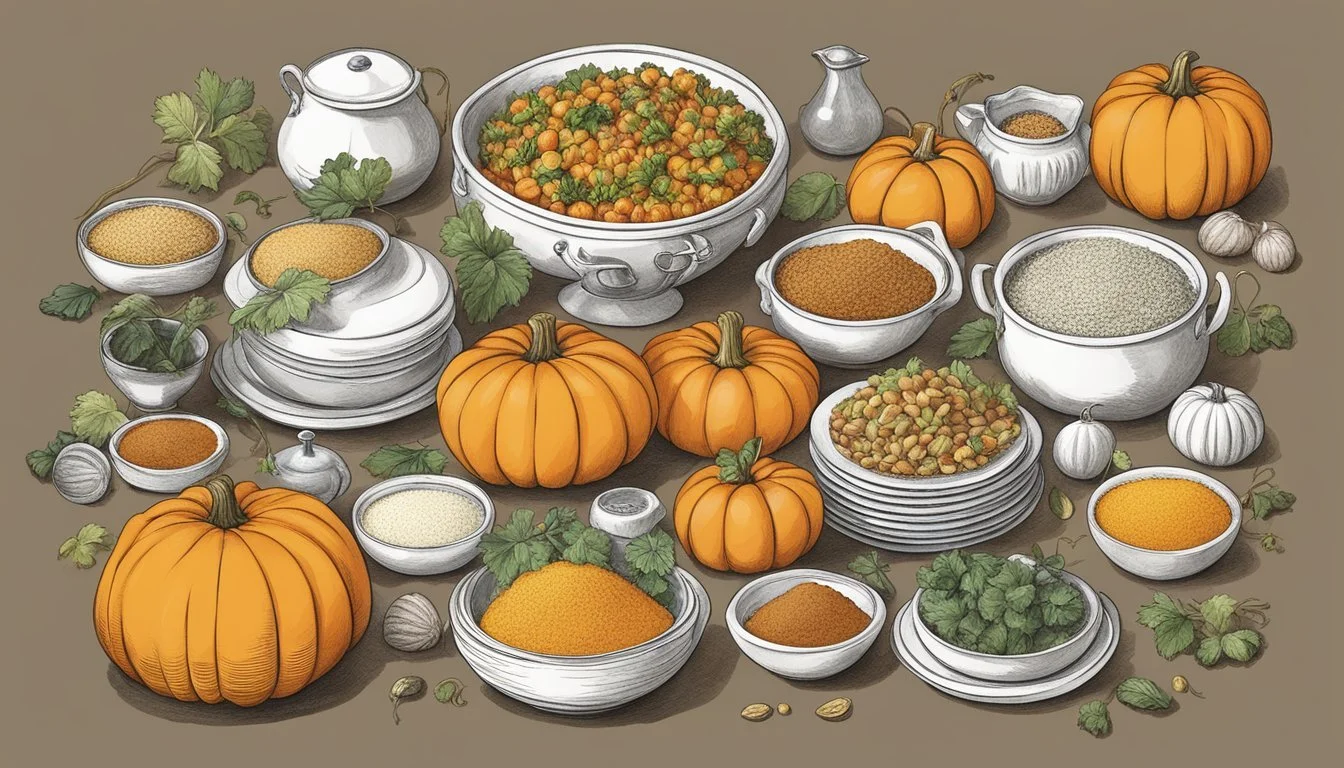Fluted Pumpkin Substitutes
Top Alternatives for Cooking and Nutrition
When it comes to cooking with fluted pumpkin, finding suitable substitutes can be essential for those moments when this unique ingredient is unavailable. Sweet potatoes offer a sweet and earthy flavor with a creamy texture, making them an excellent 1:1 substitute in soups, pies, and baked goods. For those looking for a smoother texture, butternut squash with its sweet and nutty profile is another perfect alternative.
For baking and dessert recipes, mashed bananas can be a creative and flavorful substitute. Three mashed bananas can replace one cup of pumpkin puree, contributing to a delightful twist in desserts. Other options include hubbard squash and canned pumpkin, both of which can be used in equal amounts to achieve a similar texture and richness.
Choosing the right substitute depends on the dish and the desired flavor profile. With a variety of alternatives like sweet potato, butternut squash, and even mashed bananas, home cooks can maintain their culinary creativity without missing out on the special touch fluted pumpkin brings to recipes.
Understanding Fluted Pumpkin
Fluted pumpkin, also known as Telfairia occidentalis, is a leafy vegetable primarily grown in West Africa. It has unique characteristics and versatile culinary uses.
Characteristics of Fluted Pumpkin
Fluted pumpkin leaves are dark green and have a slightly bitter taste, similar to a combination of spinach, green beans, and broccoli. The plant grows as a climbing vine and produces large, gourd-like fruits. The seeds inside the fruit are edible and often used in various dishes.
Nutritionally, fluted pumpkin is rich in vitamins A and C, iron, and potassium. This makes it a valuable ingredient in promoting overall health. The leaves also contain a significant amount of protein, which is essential for body repair and muscle growth.
Culinary Uses of Fluted Pumpkin
In cooking, fluted pumpkin is often used in soups, stews, and sauces. Its slightly bitter flavor complements rich, hearty dishes. The leaves can be chopped and added directly to boiling dishes or sautéed with onions and tomatoes for a quick side dish.
Common Dishes:
Egusi Soup
Ogbono Soup
Stir-fried fluted pumpkin with garlic and onions
When preparing the pumpkin for cooking, it is important to wash the leaves thoroughly to remove any dirt or pesticide residues. The seeds are also used in making traditional African soups and can be roasted and eaten as snacks.
Primary Substitutes and Their Qualities
Substituting fluted pumpkin in recipes can be effectively achieved using butternut squash, sweet potato, or acorn squash. Each brings unique qualities to enhance your dish, from sweetness to texture to nuttiness.
Butternut Squash for Sweetness
Butternut squash is a highly recommended substitute for fluted pumpkin. It offers a sweet flavor profile that closely matches that of the fluted pumpkin.
How to use: Use a 1:1 ratio when substituting butternut squash for fluted pumpkin. Whether roasted or puréed, butternut squash enhances the natural sweetness of dishes. Ensure to use unsweetened purée to maintain the intended flavors.
Roasting or baking the squash can bolster its depth of flavor, making it a versatile option for both sweet and savory recipes.
Sweet Potato for Texture
Sweet potato is another excellent option when looking for a fluted pumpkin substitute, primarily due to its tender texture.
How to use: Use a 1:1 ratio for substitution. Boiling, mashing, or puréeing sweet potato creates a smooth consistency, ideal for soups, purées, and baked goods.
Its naturally sweet taste complements a variety of dishes, from desserts to main courses, offering versatility while maintaining a desirable texture.
Acorn Squash for Nuttiness
Acorn squash provides a unique nutty flavor, setting it apart as a distinct substitute for fluted pumpkin.
How to use: Substitution is straightforward with a 1:1 ratio. Acorn squash's dense texture mimics that of fluted pumpkin, making it a good alternative for both flavor and consistency.
Roasting acorn squash enhances its nuttiness, adding a rich flavor to soups, casseroles, and baked goods. Its versatility extends to a range of culinary applications, making it a handy substitute.
Secondary Substitutes for Flavor Depth
Incorporating secondary substitutes like carrot puree, ripe bananas, or applesauce can enhance the flavor profile and texture while maintaining the dish’s integrity. Each substitute brings unique benefits, including added sweetness, moisture, and smooth texture.
Carrot Puree for Sweetness
Carrot puree is an excellent alternative to pumpkin puree, providing natural sweetness. Carrots have a naturally sweet flavor that intensifies when cooked, making them a suitable choice.
To prepare, simply cook the carrots until soft and blend them into a puree. This substitute also adds a vibrant orange color, similar to pumpkin. Use a 1:1 ratio when replacing pumpkin puree with carrot puree. Carrot puree boosts the nutritional value by supplying beta-carotene and fiber.
Ripe Bananas for Moisture
Ripe bananas offer a uniquely sweet flavor and exceptional moisture to recipes. When mashed, they create a smooth, creamy texture that binds ingredients well. Due to their natural sweet flavor, ripe bananas can reduce the need for additional sweeteners.
For substituting, use three mashed ripe bananas for every one cup of pumpkin puree. This ratio ensures a balanced consistency, especially in baked goods. Bananas also contribute vital nutrients like potassium and vitamin C, enhancing the dish’s overall nutritional value.
Applesauce for Sweetness and Texture
Applesauce, known for its mild sweetness and smooth texture, makes a versatile substitute. It works well in both sweet and savory dishes due to its neutral flavor.
To substitute, use unsweetened applesauce in a 1:1 ratio with pumpkin puree. This maintains the recipe's balance without overwhelming it with sugar. Applesauce not only provides moisture but also acts as a fat replacer, making it ideal for healthier recipes. It’s a handy substitute for maintaining a smooth and consistent texture.
Specialty Substitutes
Choosing specialty substitutes can elevate both the flavor and texture of your dishes. Here are three notable options to consider when replacing fluted pumpkin.
Hubbard Squash in Baking
Hubbard squash, with its sweet and rich flavor, is an excellent alternative for fluted pumpkin in baking. Its dense texture makes it suitable for various desserts like pies and muffins. When using Hubbard squash, the key is to ensure it is properly cooked and pureed until smooth.
Suitable for: Pies, muffins, breads
Texture: Dense and smooth
Flavor: Sweet and rich
To substitute, use an equal amount of pureed Hubbard squash as you would fluted pumpkin. This ensures that the final product remains moist and flavorful.
Kabocha Squash in Savory Dishes
Kabocha squash, also known as Japanese pumpkin, is ideal for savory dishes. It has a sweet, nutty flavor and a creamy texture when cooked, making it a perfect addition to soups, stews, and curries. Roasting Kabocha squash enhances its natural sweetness and depth of flavor.
Suitable for: Soups, stews, curries
Texture: Creamy and smooth
Flavor: Sweet and nutty
When substituting, use a 1:1 ratio. The creamy texture helps thicken dishes without overpowering the flavors.
Pumpkin Puree Alternatives
Pumpkin puree is often used in many recipes. When looking for alternatives, options like sweet potato, butternut squash, and even bananas stand out. Each provides a unique flavor and texture to your dish.
Sweet Potato: Earthy, creamy texture; ideal for pies and baked goods.
Butternut Squash: Sweet, smooth; perfect for both sweet and savory recipes.
Banana: Adds sweetness; suitable for desserts.
Substitute Table:
Ingredient Ratio Suitable for Sweet Potato 1:1 Pies, Soups Butternut Squash 1:1 Baked Goods Banana 1 cup: 3 bananas Desserts
Using these alternatives ensures that your recipe maintains the desired consistency and taste profile without compromising on quality.
Substitutes by Dish Type
Different dishes call for varied pumpkin substitutes. Explore ideal alternatives for desserts, savory meals, and breakfast dishes to maintain flavor and texture.
Dessert-Focused Substitutes
For desserts such as pies and cakes, butternut squash and sweet potatoes make excellent substitutes for pumpkin. They share a similar sweetness and texture.
When making pumpkin pie filling, use a 1:1 ratio of butternut squash puree or sweet potato puree. Roasting them before pureeing enhances their natural sugars, thus enriching the flavor.
Kabocha squash is another great option, known for its sweetness and denser texture. This works well in creamy desserts like custards or puddings, providing a rich taste similar to pumpkin.
Mashed bananas and apple sauce can also be utilized in baked goods where moisture and sweetness are key.
For cakes and muffins, they add a unique flavor while keeping the delicacy moist.
Savory Meal Substitutes
In savory dishes like soups, casseroles, and roasted vegetables, acorn squash and carrots are practical substitutes for pumpkin.
Acorn squash has a nutty flavor that blends well in soups and casseroles. Replace pumpkin with a 1:1 ratio of acorn squash puree to achieve a similar consistency.
Carrots offer a sweet, earthy taste when pureed or chopped finely.
For roasted dishes, both acorn squash and carrots can be seasoned and baked to achieve a hearty, savory profile.
Kabocha squash also suits savory preparations well. Its starchy consistency makes it ideal for soups and stews, giving a thick, creamy texture.
Use mashed kabocha squash, in the same quantity as pumpkin, in savory pie fillings or stuffed dishes.
Breakfast Substitutes
For pumpkin-flavored breakfasts, consider using sweet potatoes, butternut squash, or banana.
Mashed sweet potatoes can replace pumpkin in pancakes or waffles, offering a similar sweetness and texture. The natural sugars in sweet potatoes enhance breakfast dishes beautifully.
Butternut squash puree is also great in oatmeal or breakfast casseroles. Prepare it in the same way as pumpkin for a consistent texture and flavor.
Mashed banana works well in pumpkin bread or muffins, lending moisture and a sweet taste.
In breakfast dishes like smoothies, bananas can be a nutritious and flavorful substitute to achieve the desired consistency without altering the overall flavor profile excessively.
Tips for Cooking with Substitutes
Cooking with substitutes for fluted pumpkin can be both rewarding and challenging. It is essential to understand how different substitutes affect sweetness, texture, and the final outcome of your recipes, particularly for baking, soups, and stews.
Adjusting for Sweetness and Texture
When using substitutes like butternut squash, acorn squash, or sweet potatoes, it’s crucial to adjust for sweetness and texture. Butternut squash and sweet potatoes offer a natural sweetness similar to fluted pumpkin. Ensure the consistency is smooth; pureeing or mashing thoroughly can achieve this.
In recipes requiring a specific texture, such as pies or cakes, blending substitutes until smooth can prevent lumps. Also, reducing added sugar in recipes may be necessary since many squash options have inherent sweetness.
Using substitutes like zucchini for savory dishes can work well by balancing moisture content. For instance, you might need to drain excess liquid from shredded zucchini to match the drier texture of the fluted pumpkin.
Considerations for Baking
When baking, selecting the right substitute can significantly impact the outcome. Butternut squash or sweet potatoes are excellent choices because they mimic the fluted pumpkin's moisture and sweetness. A 1:1 ratio is often effective, but tweak as needed based on the substitute used.
For spiced baked goods containing pumpkin spice, butternut squash's inherent sweetness and texture make it an ideal candidate. Remember to check for consistency. Purees should be smooth, and when using fresh squash or potatoes, roasting them beforehand can enhance their flavor.
Using substitutes like carrots or zucchini in muffins or bread works well too. Adjust the amount of liquid in the recipe accordingly to avoid a soggy texture. It may help to lightly squeeze shredded substitutes to remove extra moisture.
Making Soups and Stews with Substitutes
For soups and stews, choosing a substitute that maintains shape and offers a similar flavor is vital. Acorn squash and butternut squash hold their form well in soups and stews while also providing the necessary sweetness.
Roasting squash before adding it to soups can deepen the flavor profile. This technique is particularly effective when creating rich, hearty stews where depth of flavor is paramount.
If using zucchini, consider its high water content. Zucchini should be added towards the end of cooking to prevent it from becoming mushy. For a thicker consistency, consider adding a starch such as potatoes or reducing the liquid content in the recipe.
By carefully choosing and preparing your substitutes, you can successfully replicate the qualities of fluted pumpkin in your cooking, ensuring your dishes maintain their intended flavor and texture.
Health and Nutritional Perspectives
When considering substitutes for fluted pumpkin, it is essential to evaluate their caloric and nutrient profiles, as well as how they fit into various dietary needs.
Caloric and Nutrient Comparisons
Fluted pumpkin, known for its rich nutritional value, provides significant amounts of carbohydrates, proteins, fats, fiber, and essential micronutrients such as vitamins and minerals. Comparing this with potential substitutes like pumpkin, sweet potatoes, butter, and oil unearths different nutritional benefits and caloric content.
Pumpkin, for instance, is low in calories and offers a substantial amount of vitamins A, C, and E, along with dietary fiber, which supports digestive health.
Sweet potatoes are another substitute, rich in carbohydrates and fiber, providing vitamins A and C, and essential minerals like potassium and manganese.
In comparison, butter and oil are high in calories and fats, especially saturated and monounsaturated fats, with minimal vitamins and no fiber content. Here’s a simplified nutritional data comparison:
Ingredient Calories (per 100g) Protein (g) Fat (g) Fiber (g) Fluted pumpkin 20 1.9 0.2 1.1 Pumpkin 26 1.0 0.1 0.5 Sweet potatoes 86 1.6 0.1 3.0 Butter 717 0.9 81.0 0.0 Oil (Olive) 884 0.0 100.0 0.0
Dietary Considerations with Substitutes
When integrating substitutes into a diet, particularly those replacing fluted pumpkin, it is crucial to consider the dietary goals and restrictions of the individual.
For those seeking low-calorie and nutrient-dense options, using pumpkin or sweet potatoes is appropriate. They are both excellent for providing essential vitamins without excessive calories or fats.
Butter and oil should be used sparingly, especially in diets aiming to reduce saturated fat intake due to their high caloric and fat content, which can contribute to heart disease if consumed excessively.
For those needing to maintain a balanced macronutrient intake, fluted pumpkin substitutes should be chosen based on their nutrient profile. Combining nutrient-rich options like pumpkin or sweet potatoes ensures a varied intake of essential nutrients.
Individuals with specific dietary restrictions, such as low-fat diets, should avoid high-fat substitutes like butter and oil, favoring naturally nutrient-rich vegetables instead.
Ultimately, substitutes should be selected not only for their taste and culinary compatibility but also for their ability to meet specific nutritional and dietary requirements.
Creative Uses for Fluted Pumpkin Substitutes
Fluted pumpkin substitutes can transform traditional recipes and open up new culinary possibilities. They can be used in desserts, classic dishes, and even beverages to bring unique flavors and textures.
Innovative Desserts
Using fluted pumpkin substitutes in desserts can lead to delightful creations. Zucchini and sweet potato are excellent for making moist and flavorful cakes and muffins.
For pumpkin spice lovers, zucchini bread can be spiced with cinnamon, nutmeg, and cloves. Butternut squash works well in pies and tarts, providing a taste and texture akin to pumpkin pie.
Incorporate puréed butternut squash into yogurt parfaits for a nutritious and creamy treat. Apple sauce is also a versatile alternative, perfect for enhancing baked goods.
New Twists on Classic Dishes
Fluted pumpkin substitutes are great for adding a twist to classic dishes. Butternut squash is a fantastic replacement in pumpkin soups and stews, delivering a rich and slightly sweet flavor.
Carrots can be used in savory pies or combined with eggs to make a flavorful frittata. For those seeking a unique pasta dish, blending sweet potato into the sauce offers a smooth and slightly sweet profile.
Acorn squash is another substitution that pairs beautifully with roasted meats or stuffed as a main course.
Substitutes in Drinks and Smoothies
Drinks and smoothies benefit greatly from fluted pumpkin substitutes. For a refreshing pumpkin latte, banana can be blended to achieve a creamy texture while adding natural sweetness.
Peanut butter brings richness and depth to smoothies, especially when mixed with spices like cinnamon and nutmeg. Butternut squash purée can also be used in smoothies, providing a thick consistency and mild flavor that complements various fruits.
Experiment with these substitutes in your favorite beverage recipes to create new and exciting flavors.










